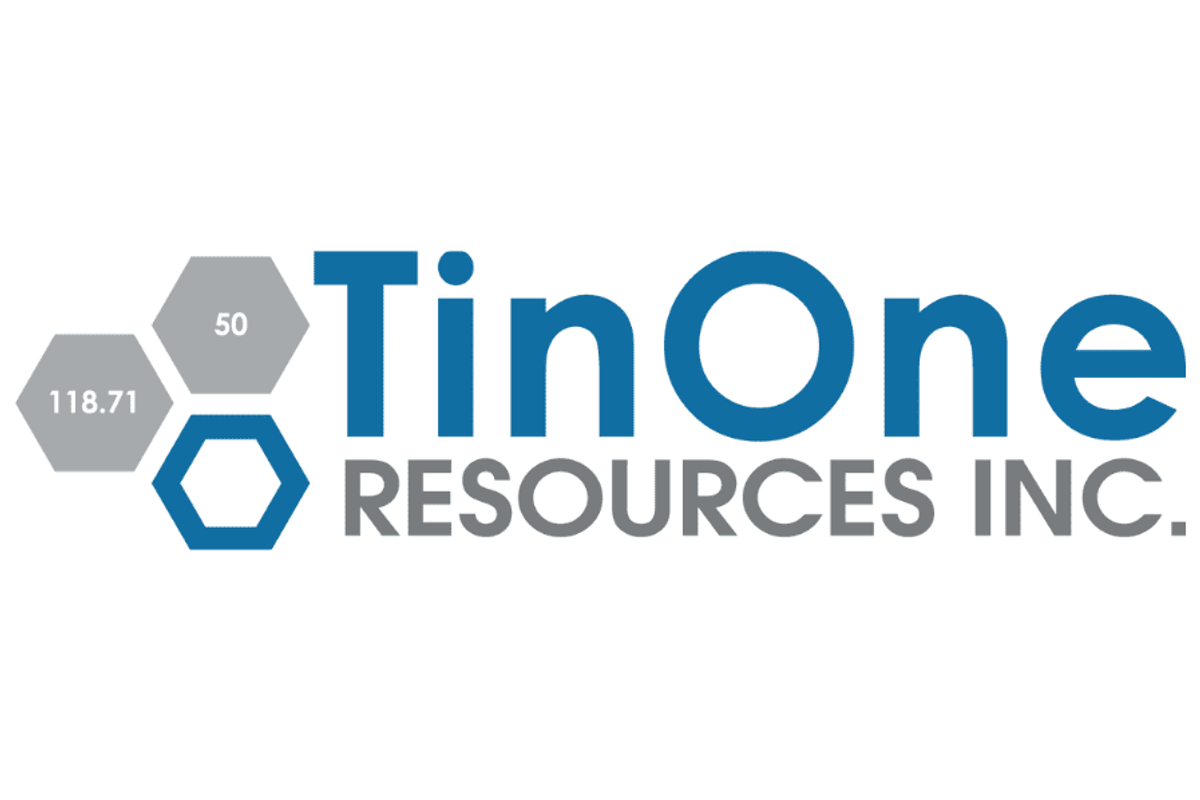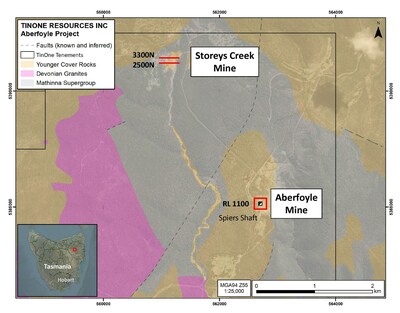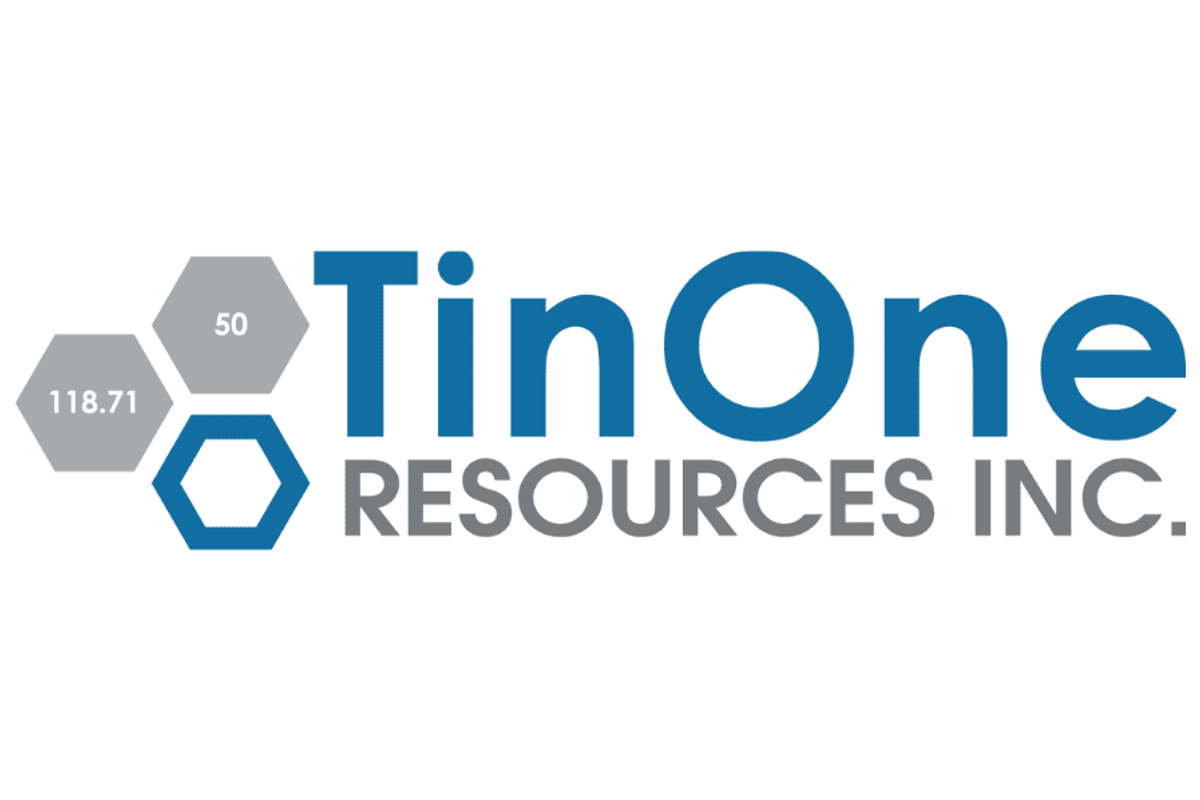
TSX.V: TORC OTCQB: TORCF
DEFINES NEW STYLE OF MINERALIZATION PERIPHERAL TO PROSPECTIVE GRANITES
TinOne Resources Inc. (TSXV: TORC) (OTCQB: TORCF) ( Frankfurt : 57Z0) (" TinOne " or the " Company ") is pleased to announce that it has identified lithium mineralization in historical core samples from its 100%-owned, 9,600-hectare Aberfoyle Project (the " Project ") located in the tier-one mining jurisdiction of Tasmania, Australia .
Highlights
- Definition of a new style of lithium mineralization at Aberfoyle :
- Select drill core samples of mica-rich sedimentary rocks, host to the prospective Devonian granites, returned up to 0.47% Li 2 O at the Storeys Creek target area.
- Strong lithium mineralization, hosted in sedimentary rocks at Storeys Creek, enhances the prospectivity criteria for lithium beyond Devonian aged granites.
- Follow-up surface sampling, geological mapping, mineralogical studies and potential drilling, in addition to further sampling of historical drill core, are warranted to fully constrain the lithium potential of the target area.
- Expanded exploration search space: These new results significantly expand the exploration search-space for lithium mineralization at Aberfoyle and elsewhere across the Company's portfolio of tin-tungsten-lithium projects in northeast Tasmania .
- Emerging lithium district: the Company holds a dominant ground position over many prospective lithium-hosting granites in northeast Tasmania .
"The identification of new lithium mineralization at the Aberfoyle Project significantly opens our exploration search space across the Project," commented Chris Donaldson , Executive Chairman . "From old core that was drilled for tin-tungsten at the historical Aberfoyle and Storeys Creek mines, we have now discovered that mica-rich sandstones proximal to the prospective granites, also carry highly anomalous lithium concentrations. This is a great result as it further confirms the presence of lithium in a new area on the property and opens additional areas for lithium exploration across the district. Plans are now underway to follow-up and expand on these results by way of systematic rock sampling and mapping across the Storeys Creek area focused on mica-bearing sandstones and also the prospective granites. While TinOne's focus remains on our Great Pyramid tin project, where we are currently concentrating on updating the resource, the exciting new lithium finds at Aberfoyle provide significant optionality for the Company."
Drill Core Sampling Program
Based on a thorough compilation of historical surface and underground drill data together with historical underground geological and structural mapping, multiple historical drill holes were selected for further review. Holes were prioritised based on the documentation and logging of coarse mica-alteration, which has shown to be locally related to lithium mineralization elsewhere on the Project (see March 15 th , 2023 news release).
The key drill holes were located at the Mineral Resources Tasmania (MRT) core storage facility at Mornington in Hobart, Tasmania . The core storage facility holds a total of approximately 4,800 metres of drill core from 59 underground holes drilled at the Storeys Creek and Aberfoyle mines. Additionally, approximately 5,500 metres of drill core from 28 holes collared at surface in the Aberfoyle-Storeys Creek area are held at the facility. The core facility also holds approximately 1,400 metres of core from the Royal George area and 380 metres from the Gipps Creek area. In addition to the core held at the facility, detailed logs from most of the historical drilling at both mines are available to the Company – 449 logs of >21,000 metres of drilling at Aberfoyle and 351 logs of >18,000 metres of drilling at Storeys Creek.
At Mornington, drill core from prioritized holes were laid out, relogged, imaged and select intervals were sampled (either half or quarter core) and submitted to the lab for full multi-element geochemical analyses. Collar information, down hole survey data, lithology, alteration and mineralization data for each hole were digitised from historical reports and were replotted in 3D software to better constrain the spatial representation of each sample. For drill holes lacking collar data, sample locations are inferred from historic underground sections (Figures 2, 3, 4). Seventeen samples were collected from drill core from seven holes at the Storeys Creek and Aberfoyle underground mines and another twenty-five samples were taken from surface holes drilled at Royal George, Gipps Creek and Storeys Creek (Figure 1). Selected analytical highlights are listed in Table 1.
Table 1. Select geochemical results from core sampling.
| Hole | Sample ID | Core | Li 2 O | Sn | WO 3 | Comments |
| U9-38 | TRD006031 | 21 | 0.47 | 0.36 | 0.01 | Hornfels of interbedded sandstone and mudstone of |
| U8-1A | TRD006044 | 91 | 0.27 | 0.02 | 0.58 | Interbedded dark grey sandstone with spotted fine |
| AU11-4 | TRD006018 | 92 | 0.20 | 0.06 | 0.01 | Variably altered fine-grained white aplite to medium- |
| U6-11 | TRD006026 | 99 | 0.13 | 0.02 | 0.01 | Medium to fine-grained white sometimes spotted |
| U6-11 | TRD006030 | 91 | 0.12 | 0.01 | 1.00 | Brown metasandstone-dominated section with light |
| AU11-4 | TRD006019 | 92 | 0.10 | 0.03 | 0.01 | As per sample TRD006018. |
| U11-7 | TRD006032 | 153 | 0.09 | 0.01 | 0.01 | Very sharp contact between dark grey hornfels and |
Highlights from the sampling program include:
- Storeys Creek – Three of the highest lithium results were from samples of sedimentary rocks representing the host lithologies to the prospective tin-tungsten bearing Devonian granites. Sample TRD006031 from hole U9-38 returned 0.47% Li 2 O (2,190 ppm Li) of a mica-rich altered sandstone cut by discrete quartz veins. This sample was collected approximately 100 m above the deeper granite (Figure 2). Sample TRD006044 from hole U8-1A returned 0.27% Li 2 O (1,275 ppm Li) collected from a sandstone cut by mica-rich veins with associated quartz and sphalerite (zinc sulfide). This sample was collected approximately 50 m above the granite (Figure 3).
The presence of strong lithium mineralization, proximal to the granites at Storeys Creek, improves the Company's exploration model for lithium across the Aberfoyle project. Additional mineralogical work, similar to the initial studies at the Dead Pig target (see March 15 th , 2023 news release) is required to constrain the nature of the sandstone-hosted lithium mineralization. Further sampling (historic drill core) and surface outcrops surrounding the Storeys Creek target are planned to better evaluate the lithium potential of the area.
- Aberfoyle Mine – Samples of drill core from historical underground holes at the Aberfoyle Mine, located 2.8 km south of the Storeys Creek area (Figure 1), returned anomalous lithium values up to 0.20% Li 2 O (Figure 4). All samples were collected from mica-altered granite (greisen alteration) with textures similar to other zones of significant lithium mineralisation such as the Dead Pig target located 6.8 km to the west (1.14% Li 2 O; see March 15 th , 2023 news release). The mineralized granite at the Aberfoyle Mine target is partially covered by relatively shallow Permian aged sediments, therefore, additional core sampling and potentially follow-up drilling are required to fully evaluate the scale of the granite-hosted lithium potential of the area.
New insights from this core sampling program together with results from the upcoming follow-up sampling and mineralogical studies will help guide future exploration programs across the Company's portfolio of highly prospective tin-tungsten-lithium projects in northeast Tasmania (Figure 5). Many of the Company's other projects are also centered on Devonian granites that intruded into Mathinna Group sedimentary rocks and have similarly not been systematically evaluated for lithium mineralization.
Analytical Procedures and QA/QC
Drill core samples were delivered to ALS Limited in Burnie, Australia from where they were forwarded to ALS Adelaide for sample preparation. Samples for analysis were forwarded to either ALS Brisbane or ALS Perth. Both the ALS Brisbane and ALS Perth facilities are ISO 9001 and ISO/IEC 17025 certified. Samples were analysed for lithium and 47 other elements via inductively coupled plasma mass spectroscopy after a four acid digestion (ICP-MS; ALS method ME-MS61).
Control samples comprising certified reference samples (including reference material certified for lithium) duplicates and blank samples were systematically inserted into the sample stream and analyzed as part of the Company's quality assurance / quality control protocol.
References
Original sections used for Figures 2-4 can be accessed via the Mineral Resources Tasmania Tiger database:
https://www.mrt.tas.gov.au/mrtdoc/ct_mineplan/ABERF_081/ABERF_081.pdf
https://www.mrt.tas.gov.au/mrtdoc/ct_mineplan/ABERF_018/ABERF_018.pdf
https://www.mrt.tas.gov.au/mrtdoc/ct_mineplan/ABERF_033/ABERF_033.pdf
https://www.mrt.tas.gov.au/mrtdoc/ct_mineplan/ABERF_222/ABERF_222.pdf
About the Aberfoyle Project
The Aberfoyle project area straddles the boundary between the Silurian to Devonian Mathinna Supergroup sedimentary rocks and the Devonian Ben Lomond Granite. The historical Aberfoyle (tin-tungsten) and Storeys Creek (tungsten-tin) mines as well as other vein systems are hosted in the sedimentary rocks and occur as strike extensive systems of sheeted and stockwork veining. Elevated lithium has not previously been reported from the Project area. Historic production 1 from the Aberfoyle Mine was estimated at 2.1Mt at 0.91% tin and 0.28% tungsten and production from Storey Creek was estimated at 1.1Mt at 1.09% tungsten and 0.18% tin.
Historical records and drilling indicate the mineralized vein system at Aberfoyle is up to 60 metres wide, 800 metres in length and extends approximately 400 metres in the down dip direction. The Lutwyche prospect occurs approximately 1 kilometre northeast of Aberfoyle and is comprised of two sets of mineralized veins which can be traced along strike for approximately 750 metres.
An additional sediment-hosted vein system, the Kookaburra, is located 200 metres southwest of the main Lutwyche vein system and is known to be approximately 40 metres wide with an along strike extent of at least several hundred metres.
Mineralization at Storeys Creek is hosted within a 30 to 50 metre wide, north-northwest striking sheeted vein array which dips to the southwest. The system can be traced along strike for 300 metres and extends 400 metres in the down dip direction. The Ben Lomond Granite crops out approximately 1km west of the mine and has been identified at depth at 180 metres below the surface.
Additional poorly known sediment-hosted vein systems occur at Brocks, Eastern Hill and elsewhere in the tenement.
Granite-hosted occurrences are developed throughout the exposed areas of granitoid outcrop and consist of vein, disseminated and breccia style occurrences with associated greisen style alteration. These have given rise to historical small scale hard rock and more extensive alluvial production in the Gipps Creek, Rex Hill , Ben Lomond , Royal George and other areas.
The Company interprets that both sediment- and granite-hosted systems have developed in structural corridors of multi-kilometre extent and that historical exploration has not systematically explored these corridors. TinOne believes systematic exploration of these prospective corridors will result in the definition of high-quality drill targets.
| 1 Data relating to historical mine production were sourced from Collins and Williams, 1986. Metallogeny and tectonic development of the Tasman Fold Belt System in Tasmania. Ore Geology Reviews 1: 153-201. |
| |
Corporate Update
The Company announces that Ben Meka has resigned from his role as Vice President, Corporate Development for TinOne to focus on corporate development opportunities within the Inventa Capital group. The Company would like to thank Mr. Meka for his contributions.
About TinOne
TinOne is a TSX Venture Exchange listed Canadian public company with a high-quality portfolio of tin, tin/tungsten and lithium projects in the Tier 1 mining jurisdictions of Tasmania and New South Wales, Australia . The Company controls some of the most important tin districts in Tasmania , including Aberfoyle , Rattler Range, Mount Maurice and Great Pyramid and is focussed on advancing its highly prospective portfolio. TinOne is supported by Inventa Capital Corp.
Qualified Person
The Company's disclosure of technical or scientific information in this press release has been reviewed and approved by Russell Fulton (MAIG), Vice President Exploration for the Company and a Qualified Person as defined under the terms of National Instrument 43-101.
Neither TSX Venture Exchange nor its Regulation Services Provider (as that term is defined in policies of the TSX Venture Exchange) accepts responsibility for the adequacy or accuracy of this release.
SPECIAL NOTE REGARDING FORWARD LOOKING STATEMENTS
This news release includes certain "Forward‐Looking Statements" within the meaning of the United States Private Securities Litigation Reform Act of 1995 and "forward‐looking information" under applicable Canadian securities laws. When used in this news release, the words "anticipate", "believe", "estimate", "expect", "target", "plan", "forecast", "may", "would", "could", "schedule" and similar words or expressions, identify forward‐looking statements or information. These forward‐looking statements or information relate to, among other things: the development of the Company's projects; future mineral exploration, development and production; and the release of exploration results.
Forward‐looking statements and forward‐looking information relating to any future mineral production, liquidity, enhanced value and capital markets profile of TinOne, future growth potential for TinOne and its business, and future exploration plans are based on management's reasonable assumptions, estimates, expectations, analyses and opinions, which are based on management's experience and perception of trends, current conditions and expected developments, and other factors that management believes are relevant and reasonable in the circumstances, but which may prove to be incorrect. Assumptions have been made regarding, among other things, the price of gold and other metals; no escalation in the severity of the COVID-19 pandemic; costs of exploration and development; the estimated costs of development of exploration projects; TinOne's ability to operate in a safe and effective manner and its ability to obtain financing on reasonable terms.
These statements reflect TinOne's respective current views with respect to future events and are necessarily based upon a number of other assumptions and estimates that, while considered reasonable by management, are inherently subject to significant business, economic, competitive, political and social uncertainties and contingencies. Many factors, both known and unknown, could cause actual results, performance or achievements to be materially different from the results, performance or achievements that are or may be expressed or implied by such forward‐looking statements or forward-looking information and TinOne has made assumptions and estimates based on or related to many of these factors. Such factors include, without limitation: the Company's dependence on early stage mineral projects; metal price volatility; risks associated with the conduct of the Company's mining activities in Australia ; regulatory, consent or permitting delays; risks relating to reliance on the Company's management team and outside contractors; risks regarding mineral resources and reserves; the Company's inability to obtain insurance to cover all risks, on a commercially reasonable basis or at all; currency fluctuations; risks regarding the failure to generate sufficient cash flow from operations; risks relating to project financing and equity issuances; risks and unknowns inherent in all mining projects, including the inaccuracy of reserves and resources, metallurgical recoveries and capital and operating costs of such projects; contests over title to properties, particularly title to undeveloped properties; laws and regulations governing the environment, health and safety; the ability of the communities in which the Company operates to manage and cope with the implications of COVID-19; the economic and financial implications of COVID-19 to the Company; operating or technical difficulties in connection with mining or development activities; employee relations, labour unrest or unavailability; the Company's interactions with surrounding communities and artisanal miners; the Company's ability to successfully integrate acquired assets; the speculative nature of exploration and development, including the risks of diminishing quantities or grades of reserves; stock market volatility; conflicts of interest among certain directors and officers; lack of liquidity for shareholders of the Company; litigation risk; and the factors identified under the caption "Risk Factors" in TinOne's management discussion and analysis. Readers are cautioned against attributing undue certainty to forward‐looking statements or forward-looking information. Although TinOne has attempted to identify important factors that could cause actual results to differ materially, there may be other factors that cause results not to be anticipated, estimated or intended. TinOne does not intend, and does not assume any obligation, to update these forward‐looking statements or forward-looking information to reflect changes in assumptions or changes in circumstances or any other events affecting such statements or information, other than as required by applicable law.
SOURCE TinOne Resources Corp.

![]() View original content to download multimedia: https://www.newswire.ca/en/releases/archive/August2023/17/c6897.html
View original content to download multimedia: https://www.newswire.ca/en/releases/archive/August2023/17/c6897.html








